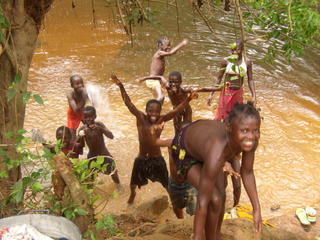
My family and I spent half the day here in Madina, a Vai village in Garwula District, Grand Cape Mount County. We came to be with our friend Kadalla, who recently lost his sister. Today is the seventh day since her burial—and, the people here believe, the day her soul loses its ability to see what is happening in the world of the living. The entire village is partaking of the traditional rituals—sharing a meal, presenting monetary gifts to the family, and remembering the young woman who grew up in their midst. It is not a sad occasion, and we are happy to be far away from the hustle and bustle of Monrovia.
Kadalla tells us only about 40% of Madina’s population remains here, on their ancestral land. Some of the people have become refugees from the civil war. (Klay, which was the site of several battles, is less than ten minutes away from where we are). Others have moved to the city in search of jobs and higher education. There is a beautiful school here, at the end of a long uphill path lined with evenly spaced palm trees on each side. But the school only goes up to 9th grade, and most Madina girls and boys end their formal education here. Kadalla says there is not one Madina girl yet who has graduated from high school. Kadalla was one of the lucky ones; he was educated by Peace Corps volunteers, won a scholarship to St. John’s High School in Robertsport, and eventually graduated from the University of Liberia. He is also one of the rare ones—a village son who has never forgotten or deserted his roots.
I like Madina with its close-knit families, outdoor kitchens, and solid mud houses—some of them decorated with patterns and handprints. There are a few small convenience stores around, a large market close by, and a clinic run by World Vision, an international NGO. The residents who show us around keep apologizing for the rocky hills we have to climb and descend, but to me, the rocky hills are a major part of what makes the place so appealing. There are houses on the hills, fruit trees and lush green vegetation all around, and, in the valley, a large creek that has been fed by the Lofa River “since time immemorial” as we like to say here. There’s no running water in Madina, so the creek is vital to the lives of the people who live here. Typical of the organization evident everywhere in the village, one side of the creek is reserved for women and children, and another side for men. Today the creek is less than half its Rainy Season depth, and the children of Madina are frolicking in it as their parents and grandparents did before them. Many of them will leave this idyllic setting someday, in search of something better. But today, for them and for me, Madina is the best place to be.





